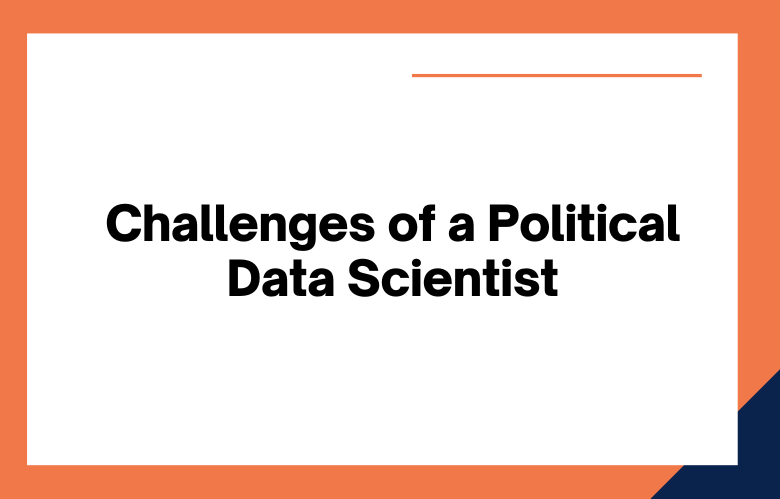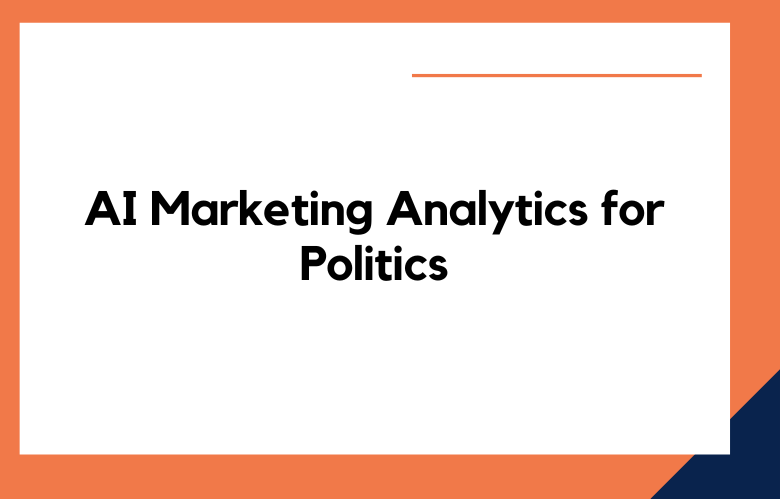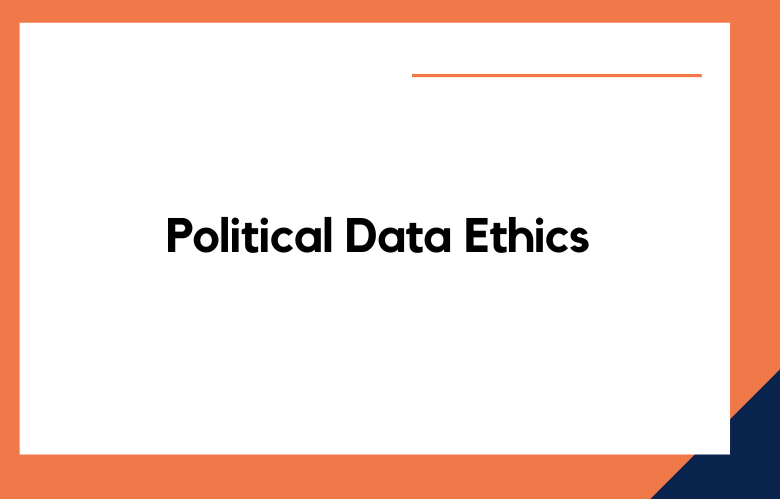In recent years, the role of data scientists has become increasingly important in the political realm. Data scientists are tasked with understanding and interpreting large amounts of data to provide insights that can help shape political strategy and decision-making.
While data science offers many opportunities for those interested in politics, it also comes with its fair share of challenges.
The challenges of being a Political Data Scientist
Political data scientists are working with messy and incomplete data sets. Data sets used in political contexts are often compiled from various sources, making them difficult to clean and standardize.
In addition, many political data sets are private, which makes them harder to obtain and work with. Despite these challenges, data scientists must be able to make sense of messy data sets to provide valuable insights to their clients or employers.
Political data scientists are dealing with rapid change in the political landscape. Election cycles are shorter now than they used to be, and issues that were once considered settled can rapidly come into play.
This means that data scientists must be able to adapt quickly and be comfortable working with uncertain and ever-changing conditions.
Political data scientists are the sheer volume of data that is available. With the rise of social media, an unprecedented amount of data is generated daily.
Political data scientists must be able to sift through this deluge of information and identify the patterns and trends that will be most helpful in predicting election outcomes.
Another challenge is dealing with the inherent uncertainty of political data. Polling numbers can change rapidly, and what may seem like a reliable trend one day can quickly become irrelevant the next.
Political data scientists must be able to adapt their models and analyses on the fly to keep up with the ever-changing landscape.
Political data scientists must always be aware of the potential biases in their data. Whether it’s self-selection bias in opinion polls or confirmation bias in media coverage, there are many ways that outside factors can skew data. It’s up to the political data scientist to account for these biases and adjust their models accordingly.
Political data scientists are working with incomplete or inaccurate data. This is often because political data is collected in various ways, including surveys, polls, voter files, and public records. Each data source has strengths and weaknesses, making it tough to understand what’s happening.
In addition, data from some sources may need to be updated or representative of the entire population. For example, voter files only include registered voters, excluding people eligible to vote but not registered.
As a result, political data scientists must be careful when interpreting data and understand the limitations of each data source.
Political data scientists are dealing with the ever-changing landscape of politics. When you think you have accompanied the trends and patterns in the data, something changes, and you have to start all over again. This can be frustrating, but it’s also the most exciting part of the job!
Political data scientists must constantly learn and keep up with the latest changes to provide accurate and timely analysis.
Dealing with changes in the Political Landscape
The political landscape is constantly changing. Candidates come and go, election laws are enacted and repealed, and new technologies are continually developing. It means that data scientists working in politics have to be constantly adaptable and able to adjust their approach on the fly.
The best way to deal with the challenge is to stay posted on updates to the political world. This way, you’ll anticipate changes before they happen and adjust your strategy accordingly. Additionally, you must have a solid team to rely on for support when things get tough.
Keeping up with the latest Data Mining Techniques
Data mining is an ever-evolving field. New techniques are continuously developing, and it can take time to keep up. Fortunately, there are some things you can stay ahead of the curve:
- Make sure you subscribe to all the major data mining publications and journals.
- Attend as many conferences and seminars as you can.
- Get involved in the online data mining community by joining forums and participating in discussions.
Working with Incomplete or inaccurate data
It’s common for political data scientists to work with incomplete or inaccurate data sets. This can be frustrating, but it’s just part of the job. The best way to deal with the challenge is to develop a strong understanding of statistical methods and learn how to use them effectively.
Additionally, always try to corroborate your data with other sources whenever possible to ensure that what you’re working with is accurate.
Politics is constantly changing. When I started working in this field, Facebook was a big new thing. Now, new social media platforms are popping up all the time. And each has its own data set that needs to be collected and analyzed. It can be hard to keep up!
Data sometimes tell us things we don’t want to hear. We might think we have the perfect plan, but the data shows it’s not working. That can be frustrating, but listening to the data is essential. After all, our goal is to win elections, not just to feel good about ourselves.
Firm understanding of data. It means being able to analyze and interpret data sets effectively. It also means having a solid experience in statistical methods. With this foundation, it will be easier to communicate your findings to others.
Good grasp of the political process and the various players involved. It also means being up-to-date on current events and trends. This knowledge contextualizes your data and makes accurate predictions easy.
Able to effectively communicate your findings to both data and non-data people. Data people are typically more interested in the numbers and the technical details.
Non-data people generally are more interested in your data’s story. If you can effectively communicate with both groups, you will be more successful as a political data scientist.
Political data scientists are the evil-minded data they have to deal with it. Most campaigns generate gigabytes or even terabytes of data per day. It includes everything from voter rolls and donation records to social media posts and website analytics.
It can be hard to try to make sense of all this data, but political data scientists must be up to it. They need to sift through all the noise and find the signal quickly.
They are dealing with rapidly changing circumstances. Campaigns are constantly evolving organisms; what worked yesterday might not work today.
This means that political data scientists need to be flexible and adaptable. They need to be able to prototype new models and experiment with different approaches rapidly. You think on your feet is critical in this field.
The data landscape is constantly changing.
One of the political data scientists‘ most significant challenges is that the data landscape is constantly changing. New data sources are continually created, and old data sources are frequently updated or discontinued.
This can make it challenging to keep up with the latest changes and ensure the data is accurate and up-to-date.
The political landscape is constantly changing, and so is the data landscape. Political data scientists need to be updated with the latest changes in the political and data landscapes to succeed.
There is a lot of disturbance in the data.
Another challenge faced by political data scientists is that there is a lot of noise in the data. This noise can come from various sources, such as errors in data collection or incorrect assumptions about the data. This noise can make it difficult to identify meaningful patterns and insights in the data.
The data is often unstructured.
Another political challenge data scientists face is that the data could be more structured. It can be challenging to clean and prepare the data for analysis. Additionally, unstructured data can be more difficult to analyze than structured data, as it may need to organize in a way that’s easy to extract insights.
Political campaigns are complex systems.
Political campaigns are complex systems, and understanding how these systems work can challenge political data scientists. Campaigns involve many moving parts, including fundraising, advertising, field operations, and voter outreach.
Modeling these complex systems can be complicated; even small changes can significantly impact campaign outcomes.
There is always uncertainty about the future.
One of the inherent challenges of being a political data scientist is that there is always uncertainty about the future. Elections are inherently unpredictable, and forecasting election outcomes is often more art than science.
Political data scientists must constantly account for this uncertainty when analyzing data and predicting future events.
There is a lot of data to sift through.
More data is out there, and it can take time to sift through all of it to find the gems that will help you achieve your goals. Political data scientists need to be able to find the data they need to be successful promptly.
Data can be noisy
Not all data is created equal, and some can be pretty noisy. Political data scientists need to be able to filter out the noise to find the signal that will help them achieve their goals.
Models can be complex.
Political data scientists use models that can be pretty complex and take time to understand all the moving parts. Political data scientists need to understand how their models work to be successful.
There is always more to do
The field of political data science is constantly evolving, and there is always more to learn. Political data scientists need to be lifelong learners to be successful.
The need for speed
In the world of politics, things move quickly. Political data scientists must be able to work promptly and efficiently to provide timely insights.
Dealing with messy data
Political data is often messy and incomplete. Political data scientists must be able to clean and wrangle data to make it usable.
Making sense of complex issues
Politics is a complex field, and political data scientists must be able to synthesize complex information and distill it into actionable insights.
Communicating effectively with non-technical stakeholders
Political data scientists must be able to communicate their findings effectively to non-technical stakeholders such as politicians, journalists, and the general public.
The role of a political data scientist is to collect and analyze data that can be used to help a political campaign make decisions about strategy, tactics, and messaging.
Political data scientists must be able to understand and work with complex data sets that often include voter data, demographic data, poll data, and social media data.
Political data scientists must be able to quickly analyze and interpret data to provide insights that can be used by campaign staff in real-time.
Political campaigns are often fast-paced and chaotic, making it difficult for data scientists to do their jobs effectively.
Data scientists working on political campaigns must work well under pressure and meet deadlines.
Political campaigns are often heavily reliant on fundraising, so data scientists working on these campaigns must be able to understand and use donor data effectively.
To be successful, political data scientists must have a strong understanding of statistics and computer science.
Political data scientists must be able to communicate their findings to non-technical staff and decision-makers within a campaign.
Political data scientists are that the field is constantly changing and evolving, so practitioners must be willing to learn new skills and continuously keep up with new technologies.
The political data scientist field is relatively new, so these professionals only sometimes have a clear career path or job market.
There is more data out there, which can be overwhelming
Another challenge of being a political data scientist is that a lot of data is out there and can be overwhelming. With so many data sources available, knowing where to start or even where to look can take time and effort.
This is why it’s possible to have a good understanding of the political process, narrow your focus, and target the data most relevant to your analysis.
The quality of data can vary greatly.
Another challenge you face as a political data scientist is that data quality can vary greatly. Some data sources are more reliable than others, and some data may be more accurate than others. This means you should assess data quality before using it in your analysis.
Data can be biased
Another challenge as a political data scientist is that data can be biased. This means that you should be aware of potential biases in your data and take steps to ensure that these biases are not affecting your results.
You can communicate your findings effectively.
One final challenge you face as a political data scientist is that you can communicate your findings effectively. This means being able to explain your results in plain language and being able to present your findings in a way that is easy for decision-makers to understand.
Conclusion
The field of political data science is challenging but also incredibly rewarding.
Those interested in politics with the skillset necessary to succeed in data science will find plenty of opportunities to make a difference in the political realm.
Despite the challenges, working as a political data scientist can be an incredibly fulfilling experience.
There are many challenges for political data scientists, but the potential rewards are great.
With the right mix of all the necessary skills, a political data scientist can significantly impact the outcome of elections.
Contact us for consultation if you need help navigating the political data landscape.
Our team has the best experience to help you make sense of the data and use it to your advantage.
Call: +91 9848321284
Email: [email protected]











